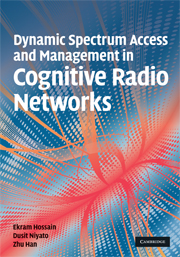Book contents
- Frontmatter
- Contents
- Preface
- Part I Introduction
- Part II Techniques for design, analysis, and optimization of dynamic spectrum access and management
- Part III Dynamic spectrum access and management
- 7 Dynamic spectrum access: models, architectures, and control
- 8 Centralized dynamic spectrum access
- 9 Distributed dynamic spectrum access: cooperative and non-cooperative approaches
- 10 Distributed dynamic spectrum access: learning algorithms and protocols
- 11 Economics of dynamic spectrum access: spectrum trading
- 12 Economics of dynamic spectrum access: applications of spectrum trading models
- References
- Index
7 - Dynamic spectrum access: models, architectures, and control
from Part III - Dynamic spectrum access and management
Published online by Cambridge University Press: 26 February 2010
- Frontmatter
- Contents
- Preface
- Part I Introduction
- Part II Techniques for design, analysis, and optimization of dynamic spectrum access and management
- Part III Dynamic spectrum access and management
- 7 Dynamic spectrum access: models, architectures, and control
- 8 Centralized dynamic spectrum access
- 9 Distributed dynamic spectrum access: cooperative and non-cooperative approaches
- 10 Distributed dynamic spectrum access: learning algorithms and protocols
- 11 Economics of dynamic spectrum access: spectrum trading
- 12 Economics of dynamic spectrum access: applications of spectrum trading models
- References
- Index
Summary
Dynamic spectrum access (DSA) models for cognitive radio can be categorized as exclusive-use, shared-use, and commons models. In the exclusive-use model, a licensed user can grant an unlicensed user the right to have exclusive access to the spectrum. In a shared-use model, an unlicensed user accesses the spectrum opportunistically without interrupting a licensed user. In a commons model, an unlicensed user can access the spectrum freely. DSA can be implemented in a centralized or a distributed cognitive network architecture. DSA can be optimized globally in a cognitive radio network if a central controller is available. On the other hand, when a central controller is not available, distributed algorithms would be required for dynamic spectrum access. Issues related to spectrum trading such as pricing will also need to be considered for dynamic spectrum access, especially with the exclusive-use model. For DSA-based cognitive radio networks, MAC protocols designed for traditional wireless networks have to be modified to include spectrum sensing and spectrum access, as well as spectrum trading between licensed and unlicensed users.
In this chapter, we describe the different spectrum access models and the system architectures for DSA. Then, two major components of dynamic spectrum access, namely, spectrum sensing and spectrum access, are presented. Spectrum sensing, which can be implemented in both physical and MAC layers, is used to detect the presence of a licensed user. In this case, an unlicensed user observes the target frequency band and searches for a signal from a licensed user. The spectrum sensing result is used by the unlicensed user to access the spectrum without interfering with the licensed user and colliding with other unlicensed users.
Information
- Type
- Chapter
- Information
- Publisher: Cambridge University PressPrint publication year: 2009
